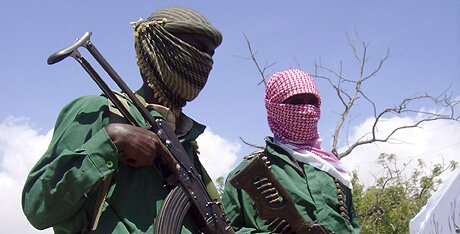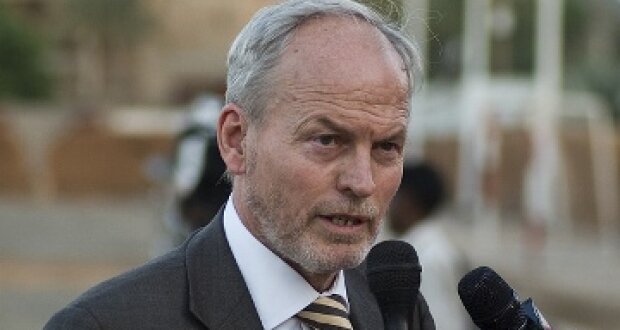 By MACHARIA GAITHO in NAIROBI and MUCHEMI WACHIRA and ISSA HUSSEIN in HULUGHO (Daily Nation) — The statement last week of Kenya’s intention to help “crush†the insurgency in Somalia is the strongest government response so far to the crisis in the troubled eastern neighbour.
By MACHARIA GAITHO in NAIROBI and MUCHEMI WACHIRA and ISSA HUSSEIN in HULUGHO (Daily Nation) — The statement last week of Kenya’s intention to help “crush†the insurgency in Somalia is the strongest government response so far to the crisis in the troubled eastern neighbour.
Foreign minister Moses Wetang’ula did not specify what sort of intervention Kenya could make in support of the beleaguered Transitional Federal Government of Sheikh Sharif Ahmed Sharif, but the strong terms he used echoed the positions already taken by the African Union and the regional organisation, Igad (Inter-governmental Authority on Development).
Both have in recent days taken positions in unequivocal support of the Somali government and condemnation of the al Shabaab militia and the Islamist grouping led by Sheikh Hassan Dahir Aweys.
Somalia has been Kenya’s most enduring security headache since independence, starting with the Shifta movement that waged a secessionist war supported by Mogadishu in the 1960s; onto the present threats posed by the infiltration of global terrorist groups like al-Qaeda into the governance vacuum in Somalia.
Al Shabbab, the Islamist militia group currently engaging government forces in Mogadishu, makes no secret of its links to Osama bin Laden’s al-Qaeda network, and that would be a major concern to Kenya.
The devastating 1998 bombing targeting the US embassy that killed more than 200 people in the heart of Nairobi was traced to radicals who had infiltrated the country through Somali.
The Paradise Hotel bombing in Kikambala in which more than a dozen people died in 2002 was also coordinated from Somalia.
Some of the key leaders of the East African Al-Qaeda cell that planned the two bombings are believed to be still operating in Somalia and playing key roles in managing the Islamist militias that now threaten to topple the transitional government.
As of much concern to Kenya is that the militia leaders have also openly espoused the “Greater†Somalia dream that drove the shifta war, aiming at bringing under one flag all the Somali-speaking areas in the region including Kenya’s North Eastern Province, the Ogaden province in Ethiopia and the Republic of Djibouti off the Red Sea.
The possibility of a radical administration in Somalia that speaks proudly of its admiration for al-Qaeda and its methods and also covets the North Eastern Province and Ogaden presents a security nightmare for both Kenya and Ethiopia.
The two countries have been military allies since they jointly countered the shifta threat in the 1960s. They remained allies even in the 1970s and 1980 despite diverging sharply ideologically — Ethiopia under Mengistu was a Soviet client state while Kenya was in the western orbit — but remaining united by a common threat.
Kenya has always sought to play the honest broker in Somalia, hosting the lengthy talks that formed the transitional government (TFG), while Ethiopia has been more aggressive.
When Ethiopia sent troops into Somalia in 2006 to drive out the Union of Islamic Courts regime that had kept the TFG out of Mogadishu, Kenya officially remained on the sidelines, but covertly was deeply involved, particularly with a heavy military presence that virtually sealed the border in order to catch the fleeing militants.
Some of those arrested at the time were handed over to the Ethiopians or to the Americans, and those considered most dangerous were shipped off to the infamous US detention camp in Guantanamo Bay.
Some of the key Islamist leaders nabbed, particularly the political and religious leaders rather than military commanders, were however quietly allowed to fly out to exile in Eritrea and Yemen. Some of them, including Sheikh Aweys, now look poised to regain power as the TFG has become increasingly weaker since the departure of Ethiopian troops.
The mainly African Union forces in Mogadishu, mainly from Uganda, are unlikely to withstand a strong onslaught, but it remains to be seen whether the African Union will move beyond rhetoric to provide real military backing to the TFG.
Kenya and Ethiopia have been at the forefront of pushing for a sting African response to the Somali situation. At the Igad Council of Ministers meting in Addis Ababa on May 20, the two countries were key to the resolution that condemned “aggression†against Somalia by al-Shabaab and Hizbul Islam (Islamic Party led Sheikh Aweys).
Igad called for the UN Security Council and foreign navies patrolling the Indian ocean to help enforce a sea and air blockade designed to prevent arms reaching the “insurgents†and also to arrest the influx of foreign fighters into the conflict.
Igad also condemned a member-state, Eritrea, for arming and training the militants, calling also for sanctions on the Red Sea country that has been at odds with Ethiopia.
The communiqué also called for member countries to provide all necessary help, including military, to the TFG.
The Igad communiqué was endorsed two days later by the AU Peace and Security Council meeting in Addis Ababa, which echoed the call for sea and air blockade and military help for the transitional government.
It is unclear, however, what kind of help can be provided. The AU peacekeeping force of less than 5,000 solders is a puny effort that is not a capable of resisting the militants. Previous pledges by many African countries to contribute troops have come to nought.
It is not clear whether Ethiopia might want to go in on its own, but it might be more than willing to go in as part of an Igad-African Union military force. Other countries that might be asked to join such a mission would naturally be Kenya, as well as Uganda, Djibouti and Sudan.
The complication is that such an intervention would consist of a combat force, not mere peacekeeping, and it remains unclear whether many countries would want to commit at that level.
Whatever happens, Kenya must be closely watching developments. The Greater Somalia dream and the terrorism threat aside, the two countries are bound together by an umbilical cord that cannot be easily severed.
Easy to police
The vast North Eastern Province is linked through religion and ethnic ties to Somalia. The vast border stretching all the way from northern Kenya to the Indian Ocean north of Lamu will never be easy to police.
Even now when the Kenya Somali border is officially closed, a thriving trade goes on.
Then there will the fear of an uncontrolled refugee influx if the security situation gets worse. In the early 1990s when the government of Siad Barre fell, Kenya hosted nearly 500,000 Somali refugees.
The number has gone down to around 150,000 according to UN estimates, but there has been an upsurge of fresh arrivals in recent weeks.
An enduring security problem is that many refugees are undocumented, having left the refugee camps to settle in urban areas, or never having registered at the camps in the first place.
Kenya has put up a massive military surveillance operation along the border, but the presence of troops is not yet as pervasive as it was in 2006 when Ethiopian forces ran the Union of Islamic Courts militants out of the country. In the border towns, even at Sinai border in Hulugho where the militants fled through, military forces are mostly confined to barracks.
But at Amumo and Liboi entry points in Fafi and Lagdera districts respectively, the military is actively patrolling the border. The rapid deployment unit of the Administration Police force is also manning Harhar Border point, which serves as an entry point from Dobley in Somalia to Liboi in Kenya.
Currently at Sinai, life seems almost normal, as pastoralists and traders from both sides cross the “closed†border with ease. Traders are daily transporting goods from Somalia into Kenya.
Seek refuge
Asked the difference between now and 2006, a local resident Mrs Habiba Ali said: “We are feeling safe unlike in 2006 when we fled from our homestead to seek refuge in Hulugho Town. Our children are learning in the three classrooms built by the government and life is very okay with our Somali neighbours in Kolbio.â€
Currently, it is only in Amumo and Liboi where a high influx of refugees has been reported.






